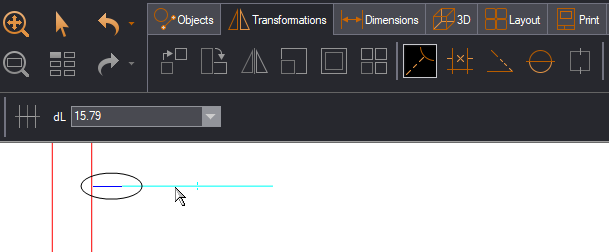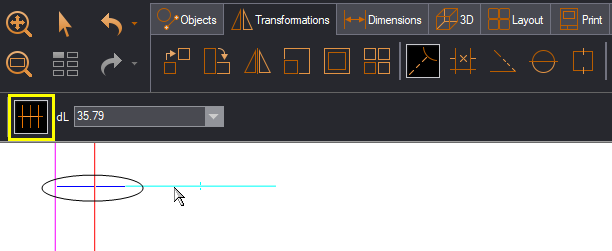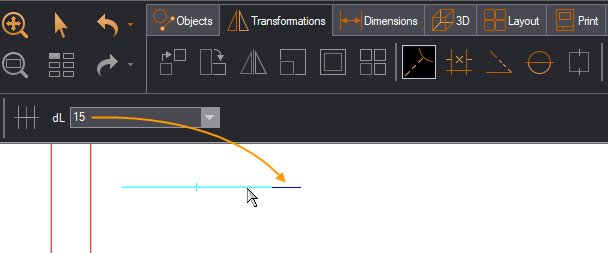You can extend and shorten only regular
lines and arcs. When you extend or shorten a line or an arc, EngView
applies the action either by using a fixed distance or to the nearest
point of intersection with another object.
To extend a line
- Do any of the following:
- On the ,
click Extend
 .
.
- On the Transformations menu, click Extend.
- Press CTRL+T+E.
A contextual edit bar appears above the graphical
area.

- Consider your situation:
- Ensure that dL is empty and no objects are selected
in the graphical area.
- Point to the half of the line segment that you want to
extend.
If there is at least one object lying on the line's extension
path, EngView
extends the line to the first intersection point. The distance
between the line's end and the intersection point appears in dL.

- Click to fix the extension.
- Select the object to which you want to extend a line.
- Press the Use Selected button
 and
ensure that dL is empty.
and
ensure that dL is empty.
- Point to the half of the line segment that you want to
extend.
EngView
extends the line only if it has a point of intersection with the
selected object. Any points of intersection with unselected objects
are ignored.

- In dL, type a positive value for the distance by
which you want to extend the object, and then press ENTER.
Nothing will take place that you can see
on the screen.
- Rest the mouse pointer over the half of the line that you
want to extend.

- Click to extend.
- In dL, enter a negative value for the distance by
which you want to shorten the object, and then press ENTER.
Nothing will take place that you can see
on the screen.
- Rest the mouse pointer over the half of the line which
you want to extend.
- Click to fix the extension.
- Ensure that dL is empty and that no objects lie
on the line's extension path: (1) Click the half of the line
that you want to extend, (2) release the mouse button, and
then (3) move the mouse in the direction that you want.
A projection of the extended line appears
following the movement of the pointer.

- Click to fix the extension.
NOTE: You can use this procedure also to shorten
a line: (1) Click the line, and then (2) Move the mouse pointer
along the line.
When you are working with a pair of
collinear lines, you can swiftly extend one of them to the other
one, thus merging the two into a new line.
- Take two collinear lines. We'll extend the lower line to
meet the upper one.

The lower line will become longer and meet
the upper one.
- On the Transformation tab, click Extend.
- Position the mouse pointer over the line that you want
to extend to the second one.
NOTE: Notice the small horizontal end marker. It
indicates where the extension will end.

The extension line reaches up to the upper
line, and it is there that it will meet it when you click.
- Click the line. This extends the lower line to meet the
second line, and the two merge into a single line.
TIP: You can draw the extension yourself and decide
how long you want it to be. In Step 3, hold down CTRL, and start
moving the mouse pointer along the line. Notice how that the extension
line moves as you move the mouse. Choose how long you want the
extension to be, and then click to fix it. See the following image.

Move the mouse to choose the length of the
extension.

 and
ensure that dL is empty.
and
ensure that dL is empty.